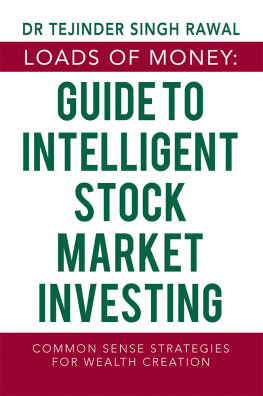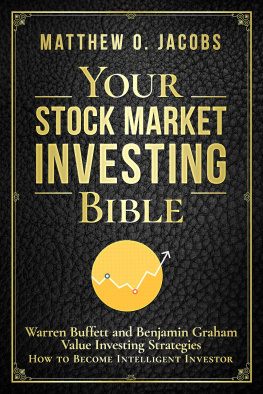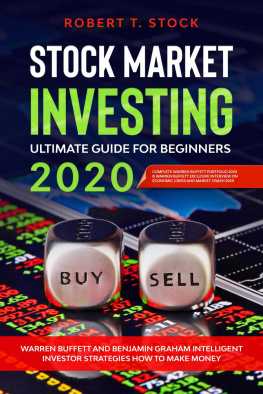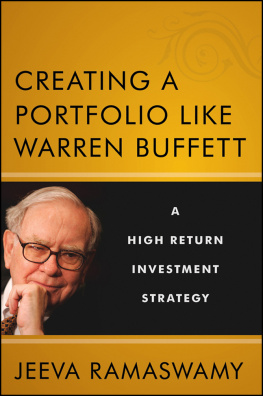LOADS OF MONEY:
GUIDE TO
INTELLIGENT
STOCK
MARKET
INVESTING
COMMON SENSE STRATEGIES
FOR WEALTH CREATION
DR TEJINDER SINGH RAWAL

Copyright 2019 by Dr Tejinder Singh Rawal.
ISBN: Hardcover 978-1-5437-0456-3
Softcover 978-1-5437-0455-6
eBook 978-1-5437-0457-0
All rights reserved. No part of this book may be used or reproduced by any means, graphic, electronic, or mechanical, including photocopying, recording, taping or by any information storage retrieval system without the written permission of the author except in the case of brief quotations embodied in critical articles and reviews.
Because of the dynamic nature of the Internet, any web addresses or links contained in this book may have changed since publication and may no longer be valid. The views expressed in this work are solely those of the author and do not necessarily reflect the views of the publisher, and the publisher hereby disclaims any responsibility for them.
www.partridgepublishing.com/india
This book is dedicated to all the wise men and women:
who investigate before they invest
who wait before they criticise
who listen before they speak
who save before they retire
who think before they write
who earn before they spend
who try before they quit
who give before they die.
CONTENTS
Every day, self-proclaimed stock market experts tell us why the market just went up or down, as if they really knew. So where were they yesterday?
Author unknown
Congratulations on picking this book. I will mentor you to a path of investment success, where lie riches beyond imagination. However, moneymaking is not easy, nor is it quick. If you picked up this book to find a get-rich-quick formula, you are in for a big disappointment. Let me warn you in the beginning: I have not written this book with the aim of changing your fortune overnight. I intend to instil in you the fundamental philosophy required to make money with high certainty and with the least risk. It is the same philosophy that has made Warren Buffett the most successful investor and one of the richest men in the world. I am here to help you with the wisdom of the best investors of all time, distilled and presented in a format that anyone with no previous experience in investment can master and profit from it. I guarantee you success; the techniques are simple, but I must warn you that this approach to investing requires considerable discipline.
Trying to get rich quick is dangerous. To make a fast buck, you need to speculate and gamble. You must play on leverage, either by borrowing money or by speculating intraday or by trading in derivatives. The price of derivatives is subject to violent fluctuations. A price surge results in quick, handsome gains, but a fall may wipe off your whole capital.
Investing is all about taming your emotions, and this book teaches you that. During my career in finance spanning over three decades, I have mentored hundreds of people, and I found that the best results are achieved not by people with a postgraduate degree in finance but by people who stay unperturbed in the face of noise in the market. I made my first investment at age of 16; that was 37 years back. Since then I have seen people come to market, make money, lose money, and vanish from the market, never to be seen again. You seldom come across old investors. Most of them have burnt their fingers when young and have decided that stock market was not their cup of tea. Or the stress took its toll, and they died young.
Over the years, I have seen the stock market mature from being an old world institution. Trading was done by open outcry on the floor of the Bombay Stock Exchange (BSE). The brokers gathered at a counter where particular scrips were traded, and the buying and selling prices were cried out loud. When the deal was struck, the dealing clerks wrote the contract details with a pencil in a kaccha sauda book, which he later transferred to a pukka sauda book. Trading was the privilege of select South Bombay brokers.
After the trading session was over, BSE released a bhav copy, the quotes of trade done. To most of the investors, the rates became available the next day when the Economic Times published it. Economic Times would dedicate four pages to the share price of the earlier day, and the reason many people bought the paper was for that section.
Your broker gave you a contract note of the transactions executed on your behalf. There was no means of identifying the correctness of price quote: the broker often put the peak price shown in the bhav copy when you purchased it and the lowest price when you sold it. So you always ended buying at the highest rate and selling at the lowest; the difference was the gala picked by the broker.
Then followed the long and complicated procedure of delivery of physical shares. Failed deliveries, signatures difference, forged share certificates, frivolous litigationsit used to be an ordeal completing the transactions. The market was inefficient: high transaction cost, a wide gap between the buying price and selling price, frequent disputes and litigations, a long settlement period. It was tough going through the process.
Come the 1990s, and things have changed 360! Shares are in demat format now. Trading is terminal based and is no longer a prerogative of a select club. No failed deliveries. Transaction costs are low. Settlement is quick (and money can be credited into your account). The risk management system is robust. We can boast of a state-of-the-art trading platform now. You can open an online trading account and can trade from your laptop or even from your mobile phone. There is no better time to invest.
Has it helped investors make more money? No! Cost per transaction has come down, but total transaction cost has increased because of frequency of trading. Since you can trade at the click of a mouse (or on your mobile app even while travelling), impulsive buying and selling has increased. You buy at the speed of thought, and you sell at the speed of thought. You watch TV news and get panicky when you see the value of rupee sinking to a new low, and you sell off your holdings. In the earlier regime, it was the inefficiencies in the market and the tedious process of completing a transaction that prevented your impulsive and bad decisions. The technology has amplified it. Now you can make mistakes faster and lose money faster.
I have watched the developments for over thirty years. With every boom, new money enters the market. Kids with pockets full of money ride the momentum, make a quick buck, and invest more money. They even believe they have found the laws of success. Every share they buy keeps rising. They throw caution out the window. The most repeated quote echoing in the market over the years is This time, its different.
Once they become more confident, they want to make money faster. The broker tells them to go for derivatives. Futures and options (F & O) are great for making more money with less capital. F & O are leveraged; you can buy larger quantities when buying F & O and thus make money many times over. They are great instruments for losing money. When the prices go down, it can wipe off every penny from your bank account. Sooner or later, the tide turns, and the worst happens. In the next trade cycle, another set of kids with money enter the market. Those who cannot learn from history are doomed to repeat it.
I wish for Indian investors to mature with the maturing of the market. They have not. That brings me to why I wrote this book.
Why I Wrote This Book
One of my missions in life is to take people to the road of personal riches and growth. If done following the approach outlined in this book, the success rate is 100%. The following pages contain a tested approach that the best investors in the world follow to make a fortune for themselves.
Next page







